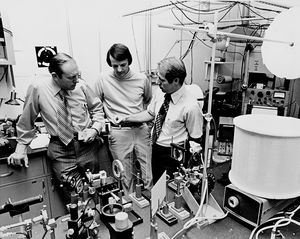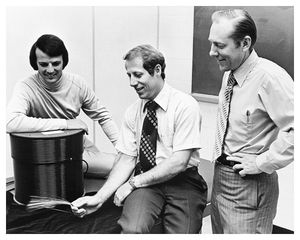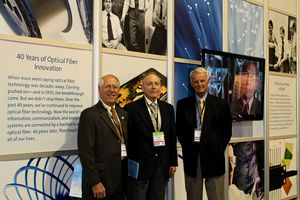Milestones:World's First Low-Loss Optical Fiber for Telecommunications, 1970: Difference between revisions
No edit summary |
|||
| (23 intermediate revisions by 5 users not shown) | |||
| Line 1: | Line 1: | ||
{{Milestone box | |||
|Date Dedicated=2012/05/01 | |||
|Dedication=121 | |||
|Location=Corning, NY, U.S.A. | |||
|IEEE Regions=1 | |||
|IEEE sections=Rochester | |||
|Additional IEEE section information=Milestone sponsored by the IEEE Photonics Society | |||
|Summary=In 1970, Corning scientists Dr. Robert Maurer, Dr. Peter Schultz, and Dr. Donald Keck developed a highly pure optical glass that effectively transmitted light signals over long distances. This astounding medium, which is thinner than a human hair, revolutionized global communications. By 2011, the world depended upon the continuous transmission of voice, data, and video along more than 1.6 billion kilometers of optical fiber installed around the globe. | |||
|StartYear=1970 | |||
|EndYear=1970 | |||
|Abstract=In 1970, Corning scientists Dr. Robert Maurer, Dr. Peter Schultz, and Dr. Donald Keck developed a highly pure optical glass that effectively transmitted light signals over long distances. This astounding medium, which is thinner than a human hair, revolutionized global communications. By 2011, the world depended upon the continuous transmission of voice, data, and video along more than 1.6 billion kilometers of optical fiber installed around the globe. | |||
|Special citation=No | |||
}} | |||
== The Worlds First Low-Loss Optical Fiber for Telecommunications, 1970 == | == The Worlds First Low-Loss Optical Fiber for Telecommunications, 1970 == | ||
[[Image:Corning Fiber-optic Inventors 3.jpg|right|thumb|1972. Dr. Robert Maurer, Dr. Peter Schultz, and Dr. Donald Keck. Sullivan Park Archive, Corning, N.Y.]] | |||
[[Image:Corning Fiber-optic Inventors 4.jpg|right|thumb|1972. Dr. Robert Maurer, Dr. Peter Schultz, and Dr. Donald Keck. Sullivan Park Archive, Corning, N.Y.]] | |||
[[Image:Corning Fiber-optic Inventors 2.jpg|right|thumb|2010. Dr. Robert Maurer, Dr. Peter Schultz, and Dr. Donald Keck. Sullivan Park Archive, Corning, N.Y.]] | |||
''In 1970, Corning scientists Dr. Robert Maurer, Dr. Peter Schultz, and Dr. Donald Keck developed a highly pure optical glass that effectively transmitted light signals over long distances. This astounding medium, which is thinner than a human hair, revolutionized global communications. By 2011, the world depended upon the continuous transmission of voice, data, and video along more than 1.6 billion kilometers of optical fiber installed around the globe.'' | ''In 1970, Corning scientists [[Robert D. Maurer|Dr. Robert Maurer]], Dr. Peter Schultz, and Dr. Donald Keck developed a highly pure optical glass that effectively transmitted light signals over long distances. This astounding medium, which is thinner than a human hair, revolutionized global communications. By 2011, the world depended upon the continuous transmission of voice, data, and video along more than 1.6 billion kilometers of optical fiber installed around the globe.'' | ||
During the mid-1960s, members of the British Post Office came to Corning seeking assistance in creating pure glass fiber optics. Their design required a single-mode fiber (100 micron diameter with a 0.75 micron core) having a total attenuation of about 20 dB/km. The very best bulk optical glasses of the day had attenuations of approximately 1,000 dB/km. This meant Corning’s scientists had to see an improvement in transparency of 1,098 in order to reach the 20 dB/km goal. It seemed impossible, but they did it, inventing an optical fiber with attenuation of 17 dBkm. As a result, Corning’s invention of the first low-loss optical fiber and the manufacturing process used to produce it revolutionized the telecommunications industry and changed the world forever. The explosion of the Internet and other information technologies would not have been possible without optical fiber. Only optical fiber provides the bandwidth required for high-speed transmission of voice, data, and video the world depends upon for the way we live, work, and play. Today, there are more than 1.6 billion kilometers of fiber installed around the globe. | During the mid-1960s, members of the British Post Office came to Corning seeking assistance in creating pure glass fiber optics. Their design required a single-mode fiber (100 micron diameter with a 0.75 micron core) having a total attenuation of about 20 dB/km. The very best bulk optical glasses of the day had attenuations of approximately 1,000 dB/km. This meant Corning’s scientists had to see an improvement in transparency of 1,098 in order to reach the 20 dB/km goal. It seemed impossible, but they did it, inventing an optical fiber with attenuation of 17 dBkm. As a result, Corning’s invention of the first low-loss optical fiber and the manufacturing process used to produce it revolutionized the telecommunications industry and changed the world forever. The explosion of the Internet and other information technologies would not have been possible without optical fiber. Only optical fiber provides the bandwidth required for high-speed transmission of voice, data, and video the world depends upon for the way we live, work, and play. Today, there are more than 1.6 billion kilometers of fiber installed around the globe. | ||
| Line 12: | Line 27: | ||
Corning. "Corning Inventors of Low-Loss Optical Fiber Receive Nation's Highest Technology Honor." Award Editorial. | Corning. "Corning Inventors of Low-Loss Optical Fiber Receive Nation's Highest Technology Honor." Award Editorial. | ||
Dyer, Davis, and Daniel Gross. The Generations of Corning: the Life and times of a Global Corporation. New York, NY | Dyer, Davis, and Daniel Gross. The Generations of Corning: the Life and times of a Global Corporation. New York, NY: Oxford UP, 2001. | ||
Graham, Margaret B. W., and Alec T. Shuldiner. Corning: and the Craft of Innovation. Oxford: Oxford UP, 2001. | |||
Hecht, Jeff. City of Light: the Story of Fiber Optics. New York: Oxford UP, 1999. | |||
Magaziner, Ira, and Mark Patinkin. The Silent War. Corning Glass: The Battle to Talk with Light. Random House, 2000. | |||
Maurer, Robert D. 3,785,716. Corning Glass Works, Corning, N.Y., assignee. Patent 3,785,716. 15 Jan. 1974. | |||
Maurer, Robert D., and Peter C. Schultz. Fused Silica Optical Waveguide. Corning Glass Works, Corning, N.Y., assignee. Patent 3,659,915. 2 May 1972. | |||
Maurer, Robert D. Method of Producing Glass for Optical Waveguides. Corning Glass Works, Corning, N.Y., assignee. Patent 3,791,714. 12 Feb. 1974. | |||
== Letter from the site owner giving permission to place IEEE milestone plaque on the property<br> == | |||
<br> | [[Media:IECRC_EE_Milestone_Nomination_Site_Confirmation_Letter_121311_(2).doc|Fiber Optic Milestone Support Letter]]<br>[[Media:Supporting_Materials.doc|Supporting Materials.doc]] | ||
== | {{Milestone|GeoLoc=42.162019, -77.094137|Description=In 1970, Corning scientists Dr. Robert Maurer, Dr. Peter Schultz, and Dr. Donald Keck developed a highly pure optical glass that effectively transmitted light signals over long distances. This astounding medium, which is thinner than a human hair, revolutionized global communications. By 2011, the world depended upon the continuous transmission of voice, data, and video along more than 1.6 billion kilometers of optical fiber installed around the globe.}} | ||
[[Category:Optics|Fiber]] [[Category:Fiber optics|Fiber]] | |||
[[Category:Optics]] | [[Category:Optics]] | ||
Latest revision as of 16:12, 14 June 2022
The Worlds First Low-Loss Optical Fiber for Telecommunications, 1970
In 1970, Corning scientists Dr. Robert Maurer, Dr. Peter Schultz, and Dr. Donald Keck developed a highly pure optical glass that effectively transmitted light signals over long distances. This astounding medium, which is thinner than a human hair, revolutionized global communications. By 2011, the world depended upon the continuous transmission of voice, data, and video along more than 1.6 billion kilometers of optical fiber installed around the globe.
During the mid-1960s, members of the British Post Office came to Corning seeking assistance in creating pure glass fiber optics. Their design required a single-mode fiber (100 micron diameter with a 0.75 micron core) having a total attenuation of about 20 dB/km. The very best bulk optical glasses of the day had attenuations of approximately 1,000 dB/km. This meant Corning’s scientists had to see an improvement in transparency of 1,098 in order to reach the 20 dB/km goal. It seemed impossible, but they did it, inventing an optical fiber with attenuation of 17 dBkm. As a result, Corning’s invention of the first low-loss optical fiber and the manufacturing process used to produce it revolutionized the telecommunications industry and changed the world forever. The explosion of the Internet and other information technologies would not have been possible without optical fiber. Only optical fiber provides the bandwidth required for high-speed transmission of voice, data, and video the world depends upon for the way we live, work, and play. Today, there are more than 1.6 billion kilometers of fiber installed around the globe.
This breakthrough work established the optical fiber category. There were no similar achievements at the time of the invention. In recognition of this achievement, the three scientists responsible for inventing low-loss optical fiber – Dr. Robert Maurer, Dr. Peter Schultz, and Dr. Donald Keck – have been inducted into the Inventors Hall of Fame and were awarded the National Medal of Technology.
References and Further Reading
Corning. "Corning Inventors of Low-Loss Optical Fiber Receive Nation's Highest Technology Honor." Award Editorial.
Dyer, Davis, and Daniel Gross. The Generations of Corning: the Life and times of a Global Corporation. New York, NY: Oxford UP, 2001.
Graham, Margaret B. W., and Alec T. Shuldiner. Corning: and the Craft of Innovation. Oxford: Oxford UP, 2001.
Hecht, Jeff. City of Light: the Story of Fiber Optics. New York: Oxford UP, 1999.
Magaziner, Ira, and Mark Patinkin. The Silent War. Corning Glass: The Battle to Talk with Light. Random House, 2000.
Maurer, Robert D. 3,785,716. Corning Glass Works, Corning, N.Y., assignee. Patent 3,785,716. 15 Jan. 1974.
Maurer, Robert D., and Peter C. Schultz. Fused Silica Optical Waveguide. Corning Glass Works, Corning, N.Y., assignee. Patent 3,659,915. 2 May 1972.
Maurer, Robert D. Method of Producing Glass for Optical Waveguides. Corning Glass Works, Corning, N.Y., assignee. Patent 3,791,714. 12 Feb. 1974.
Letter from the site owner giving permission to place IEEE milestone plaque on the property
Fiber Optic Milestone Support Letter
Supporting Materials.doc


